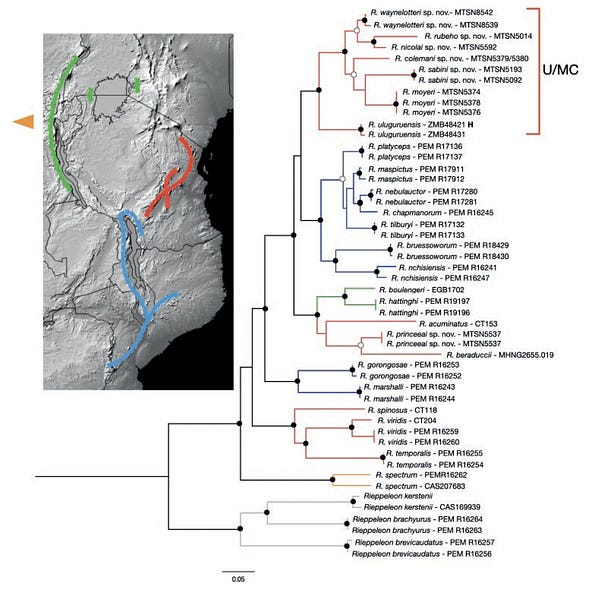New pygmy chameleons | Seychelles ant menace| Elephant bee phobia | New Okavango film
New thumb-sized species of Tanzanian chameleon named after US rapper
Two new thumb-sized species of chameleon, found in threatened evergreen forests in eastern Tanzania, have been named after a US rapper and an assassinated conservationist.
As biodiversity losses mount, the scientists hope that naming the chameleons after famous people will help draw attention to threats facing the evergreen forests of Tanzania’s Eastern Arc Mountains.
Princeeai’s Pygmy Chameleon, or Rhampholeon princeeai, is named after US rapper and poet, Prince Ea. He’s been honored because of his recent work highlighting threats to the environment, including deforestation. Wayne’s Pygmy Chameleon, or Rhampholeon waynelotteri, is named in honor of Wayne Lotter, a Tanzania-based conservationist who was assassinated on the streets of Dar es Salaam in 2017 for his work in anti-poaching.
The two tiny reptiles are among six that are new to science. All of them live in the ancient, forest-capped Eastern Arc Mountains that stretch across Tanzania from south-eastern Kenya.
But, as the authors of the study describing them note, most of the six “are at risk of extinction given that they have small distributions that have been impacted by habitat loss.”




Invasive ants disrupt plant pollination in Seychelles
Invasive ants in the Seychelles, a cluster of islands off the eastern coast of Africa, are disrupting the interaction between native winged pollinators like flies, bees, wasps and butterflies and plants found only on the island.
Research took place on the archipelago’s Mahe Island that is punctuated by granite outcrops known as inselbergs.
Here, white-footed and yellow crazy ants — two separate species accidentally introduced to the island decades ago — have been behaving in the same aggressive manner they’re known for in other parts of the world that they’ve invaded. It’s believed they chase off native pollinators by spraying them with formic acid.
Consequently, Mahe’s pollinators changed their foraging patterns, the study found.
The effects of the ant aggression lingered, even on plant buds from which ants were excluded by the research team. The pollinators spent less time at flowers and didn’t resume their normal rate of flower probing.
“This behavioral change may negatively impact on native pollination and plant reproduction,” the authors of the study stated.
The ants do also carry out pollination, but aren’t nearly as effective at it as the winged natives, which also include wasps and beetles.


Watch: rare footage shows the moment a forest elephant hears a ‘swarm of bees’
Rare camera trap footage reveals the moment an endangered forest elephant in Liberia is tricked into believing a swarm of bees is nearby.
The elephant was foraging near a farm, and triggered a remote sensor that played a recorded sound of the bees.
The so-called Buzz Box is a tool used by conservationists to discourage elephants from raiding crops and being killed or injured in retaliation by angry farmers.
At the sound of the bees the bull elephant, who had been foraging peacefully on natural vegetation, appears startled. He quickly turns around and disappears back into the forest.
The Buzz Box has been used successfully in the East African nation of Tanzania, albeit on a different species of elephant – the savanna elephant. This is the first evidence of it working effectively to deter the smaller, closely-related forest elephant.
Tina Vogt of the Liberia-based Elephant Research and Conservation (ELRECO) Group, which recorded the encounter, said getting such clear footage of the forest elephant’s reaction was a “one in a million” opportunity.
“The bull’s immediate action was amazing and, with human-elephant conflict so prevalent, it was so encouraging to see him race away from the farmland,” she said.
Take a look at the video clip via this link


New film shines a light on human communities living in the Okavango Delta
I’ve just been to Gaborone to attend the premiere of Nkashi: Race for the Okavango. It’s a new feature-length film – a collaboration between National Geographic’s Impact Story Lab, and Batswana filmmakers and creatives.
The film gets its name from the nkashi, which is a pole hewn from the silver terminalia tree and used to propel traditional canoes, or mekoro, through the waters of the delta.
The film follows the lives of three charismatic ‘polers’ — two men and a woman — as they train for an annual mokoro race. What they say sheds light on the human communities that make their home in this incredibly rich and biodiverse landscape, and are an integral part of it.
The film is in the Setswana language with English subtitles; the striking soundtrack is by popular local musician, Thato Kavinja.
It was made for a Batswana audience, but the powerful themes woven through it are universal.
Ahead of the screening on Thursday night Motswana conservationist and National Geographic Explorer Koki Mookodi described the film-making collaboration as “a two-way mentorship.” She said the Batswana crews got immersive technical experience that would help to propel their film careers forward. “The National Geographic team,” she said, “learned about communities whose stories deserve to be told.”
A red carpet for the world premiere of the Nkashi film in Gaborone | Ryan Truscott




